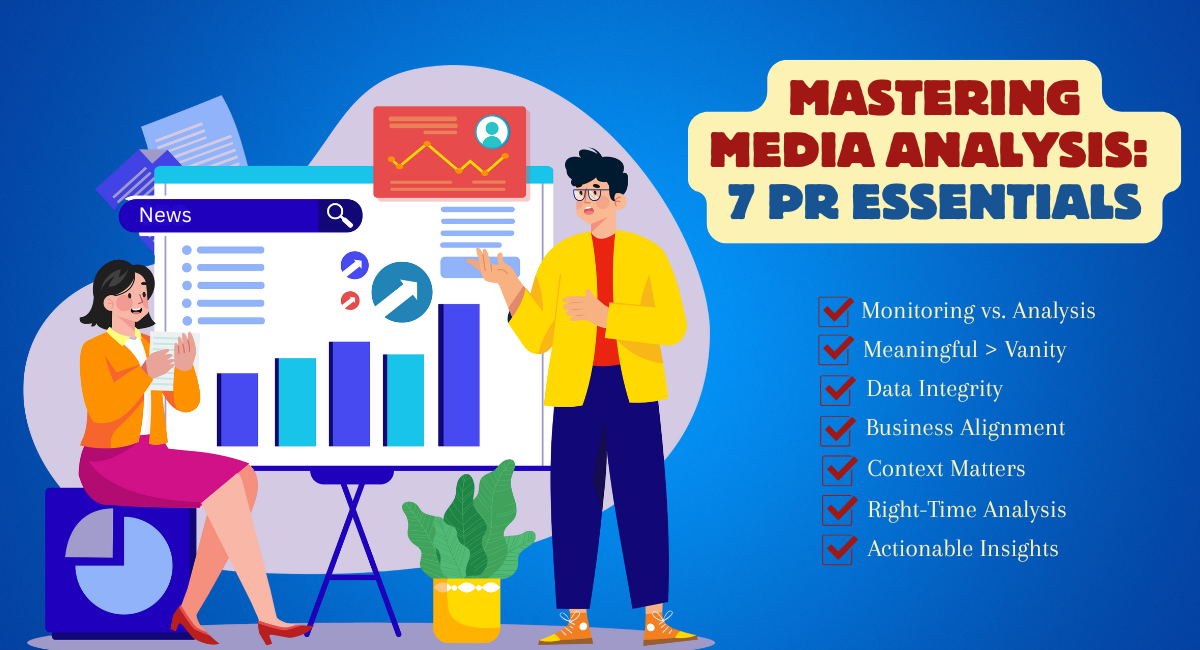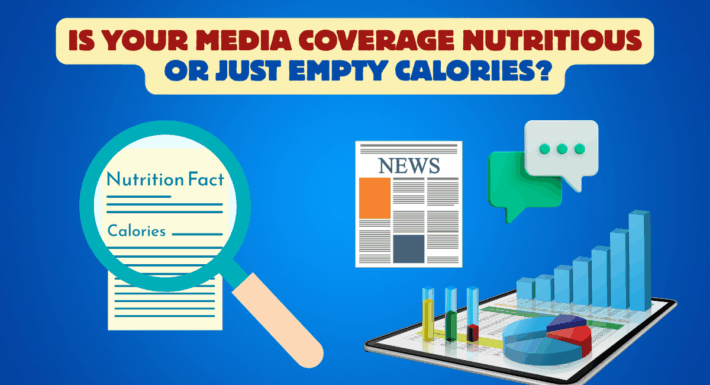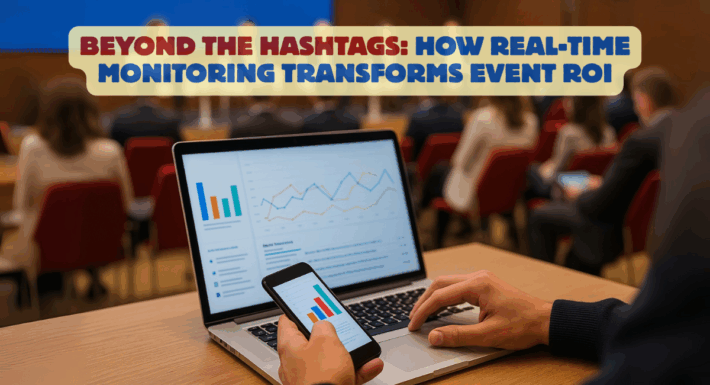Media Analysis 101: Seven Essential Things PR Pros Should Know

Over my decades in this industry, I’ve witnessed the evolution of media analysis from simple clipping services to sophisticated intelligence operations. What hasn’t changed is this fundamental truth: most PR professionals understand that media analysis is essential, but many still aren’t quite sure what separates good analysis from simply collecting a bunch of articles and calling it a day. The difference, I’ve learned, can make or break your PR strategy.
Think of media analysis like being a detective. You’re not just gathering evidence—you’re piecing together clues to solve a mystery. The mystery? Understanding what your media coverage really means for your brand, your campaigns, and your bottom line.
After years of helping PR teams transform their approach to media analysis, I’ve identified seven fundamental concepts that separate the pros from those still swimming in spreadsheets. Master these, and you’ll stop drowning in data and start surfacing insights that actually drive decisions.
1. Media Monitoring ≠ Media Analysis: Understanding the Difference and Why It Matters for PR Outcomes
Let’s start with the most common misconception in our industry. Media monitoring and media analysis are not the same thing, and confusing them is like thinking that collecting ingredients is the same as cooking a meal.
Media monitoring is your data collection phase. It’s the systematic tracking and gathering of mentions across news outlets, social media, blogs, and other digital channels. Think of it as casting a wide net to capture everything being said about your brand, competitors, or industry topics. This is like building a search engine of search engines to ensure your brand mentions are gathered across all media channels in the local language.
Media analysis, on the other hand, is where the magic happens. Here, you take that raw data and transform it into meaningful insights. You’re looking for patterns, trends, sentiment shifts, and strategic opportunities that inform your next moves. This is where you learn about your brand from the media monitoring inputs. Thousands of posts, and you need to get an executive news brief out to make sense of it all, and what is impacting sales.
Here’s why this distinction matters: I’ve seen too many PR teams produce beautiful reports filled with charts and metrics that look impressive but don’t actually tell stakeholders anything useful. They’re presenting monitoring data dressed up as analysis, and executives can sense the difference immediately.
Real media analysis answers questions like: “Why did sentiment shift last month?” “What messages are resonating with our target audience?” “How are we positioned compared to competitors in key conversations?” These insights drive strategy, not just reporting.
2. Quality Over Quantity: How Meaningful Metrics Trump Vanity Metrics in Media Analysis
Volume metrics feel satisfying—there’s something gratifying about reporting that your brand received 500 mentions this month. But here’s the reality check: not all mentions are created equal, and focusing primarily on quantity can actually mislead your strategy.
Consider this scenario: Brand A gets 1,000 mentions in trade publications with minimal reach, while Brand B gets 50 mentions in tier-one outlets with millions of readers. Which brand had the better month? The answer isn’t immediately evident from volume alone.
This is where meaningful metrics come into play. Instead of just counting mentions, focus on:
- Share of voice in key conversations: Are you dominating discussions around topics that matter to your business goals?
- Sentiment quality and context: A detailed analysis of how your brand is being discussed, not just whether it’s positive or negative
- Message penetration: How well are your key messages being adopted and repeated by media and influencers?
- Audience relevance: Are your mentions reaching the people who actually make purchasing decisions?
Think of it like this: would you rather have 100 people talking about you at a networking event where none of them are potential customers, or 10 people discussing you at a conference full of your ideal buyers? Quality always wins over quantity when it comes to meaningful business impact.
3. Data Integrity is Key: Why Clean, Consistent Data and Methodology Make or Break Your Analysis
There’s an old saying in data analysis: “Garbage in, garbage out.” This principle is absolutely critical in media analysis, yet it’s often overlooked in the rush to produce insights. Organizations like AMEC have long championed the importance of data integrity in their measurement frameworks, and for good reason.
Clean data means ensuring your monitoring setup is capturing the right conversations while filtering out irrelevant noise. I’ve seen analysis completely derailed because monitoring queries picked up discussions about a completely different company with a similar name, or because sentiment analysis couldn’t distinguish between sarcasm and genuine praise.
Consistent methodology is equally important. Your approach to categorizing mentions, measuring sentiment, and defining key metrics needs to remain stable over time. Otherwise, when you look at month-over-month trends, you’re not comparing apples to apples.
Here are the data integrity basics every PR team should implement:
- Regular query audits: Review your monitoring searches monthly to ensure they’re still capturing relevant conversations without too much noise
- Standardized categorization: Develop clear criteria for how you classify mentions by topic, audience type, and influence level
- Quality control processes: Have someone spot-check a sample of your data regularly to catch systematic errors
- Documentation: Keep detailed records of your methodology so analysis remains consistent even when team members change
Remember, executives are making real business decisions based on your analysis. Clean, reliable data isn’t just a nice-to-have—it’s the foundation of trustworthy insights.
4. Tie to Goals & Business Impact: Connect Analysis to Broader Business Objectives
Here’s where many PR teams stumble: they produce excellent analysis of media coverage but fail to connect it to what actually matters to the business. Your media analysis should serve as a bridge between PR activities and broader organizational goals.
Before diving into any analysis, ask yourself: “What business question am I trying to answer?” This might be understanding market perception before a product launch, measuring the effectiveness of a crisis response, or evaluating your competitive positioning in a key market segment.
Strategic alignment means your analysis directly supports business KPIs that executives care about:
- Brand health metrics: How is media coverage influencing brand perception surveys and customer sentiment?
- Sales enablement: Are your thought leadership efforts generating the kind of coverage that helps sales teams start conversations?
- Market share insights: How does your share of voice correlate with actual market share in key segments?
- Risk management: What early warning signals can media analysis provide about potential issues or opportunities?
When you present analysis that clearly connects media coverage to business outcomes, you transform from a service provider into a strategic advisor. Professional organizations like the Public Relations Society of America (PRSA) and the Institute for Public Relations (IPR) have been advocating this shift toward business-focused measurement for years through their research and professional development programs. Suddenly, your insights become essential reading rather than just another report in the inbox.
5. Context is Everything: Understanding the Landscape and Circumstances Behind the Data
Numbers without context are just numbers. The most valuable media analysis goes beyond reporting what happened to explain why it happened and what it means for the future.
Think of context as the background story that makes your data meaningful. A 30% increase in mention volume might seem positive until you realize it coincided with a significant industry crisis that affected all competitors. Conversely, a slight dip in coverage represents strong performance if it occurred during a typically quiet period.
Essential context elements include:
- Industry trends and seasonality: How do your results compare to typical patterns in your sector?
- Competitive landscape: What were your competitors doing during the same period that might influence your relative performance?
- External factors: Major news events, economic conditions, or cultural moments that could impact coverage
- Campaign timing: How do your results align with specific PR initiatives, product launches, or marketing campaigns?
I recommend creating a “context layer” for all your analysis—a brief section explaining the external factors that may have influenced your results. This approach helps stakeholders understand not just what your data shows but why it matters and how to interpret it correctly.
6. Timing Matters: Real-Time vs. Historical Analysis and When to Use Each
Media moves fast, but not every situation requires real-time analysis. Understanding when to use different timing approaches can significantly improve both the quality of your insights and the efficiency of your team.
Real-time analysis is crucial for:
- Crisis management and rapid response situations
- Live event monitoring (product launches, conferences, earnings calls)
- Trending topic identification and newsjacking opportunities
- Immediate competitive intelligence needs
Historical analysis provides deeper value for:
- Strategic planning and long-term trend identification
- Campaign effectiveness evaluation
- Seasonal pattern recognition
- Competitive benchmarking and market positioning studies
The key is matching your analysis timing to your business needs. I’ve seen teams exhaust themselves trying to provide real-time insights for everything, when what leadership really needed was thoughtful weekly or monthly strategic analysis.
Consider developing different cadences for different types of analysis: daily monitoring dashboards for crisis alerts, weekly tactical summaries for campaign teams, and monthly strategic deep-dives for executive leadership.
7. Actionable Insights: Moving from Data to Strategic Recommendations
The ultimate test of practical media analysis isn’t how sophisticated your charts look—it’s whether your insights lead to better decisions and actions. Every analysis concludes with clear, actionable recommendations.
Strong recommendations have three characteristics:
- Specific: Instead of “improve sentiment,” recommend “focus messaging on product reliability benefits, as 60% of negative mentions cite durability concerns.”
- Prioritized: Not every insight deserves equal attention. Rank your recommendations by potential impact and feasibility.
- Accountable: Include suggested owners, timelines, and success metrics for each recommendation.
Think of yourself as a strategic consultant rather than just a data analyst. Your job isn’t finished when you identify a trend—it’s finished when you’ve provided clear guidance on what to do about it.
For example, if your analysis reveals that your competitors are dominating conversations about sustainability while your brand is absent, don’t just report this gap. Recommend specific actions: developing sustainability-focused thought leadership content, identifying industry events where you can join these conversations, or partnering with environmental organizations to build credibility in this space.
Putting It All Together
Mastering media analysis is about more than just understanding these seven concepts—it’s about integrating them into a systematic approach that consistently delivers value to your organization.
Remember that excellent media analysis serves two masters: the immediate tactical needs of your PR team and the broader strategic needs of your business. When you can demonstrate that your insights directly contribute to business success, media analysis transforms from a reporting requirement into a competitive advantage.
The PR landscape continues to evolve rapidly, with new platforms, changing media consumption habits, and advancing AI capabilities reshaping how we monitor and analyze coverage. But these seven fundamentals will remain constant: the difference between monitoring and analysis, the importance of quality over quantity, the necessity of clean data, the connection to business goals, the power of context, the strategic use of timing, and the imperative to drive action.
Start with these basics, refine your approach based on what works for your organization, and watch as your media analysis becomes an indispensable part of your company’s decision-making process.

Ted Skinner
Ted Skinner is a Technology Executive at Fullintel who specializes in transforming SaaS growth in MarTech and AI-driven business solutions. With decades of experience spanning from his early work at eWatch—one of the original pioneers in online media monitoring—through his role as Vice President for Public Relations Products at Cision (where he was honored with the prestigious John Petrillo award for exemplary customer service), Ted has become a recognized authority in media monitoring for data-driven public relations. His insights aren’t just historical footnotes—they’re strategic catalysts, drawing on data-driven analysis and a nuanced understanding of the evolving communications ecosystem, empowering organizations to make informed, forward-looking decisions that drive sustained growth and long-term market advantage.
Follow Ted’s insights on LinkedIn at linkedin.com/in/tedskinner or read more of his analysis at fullintel.com/author/ted-skinner.
Looking to dive deeper into media analysis best practices? Check out our comprehensive guides on What Is Media Monitoring & Analysis, And Why Do It? and Why Clean Media Data Is Vital for Relevant Analysis and Insights for more tactical insights and implementation strategies. For a step-by-step approach to building effective monitoring programs, explore our Media Monitoring Mastery: The PR Professional’s Practical Guide and discover 3 Proven Steps to Gathering High-Quality Media Intelligence.
Ted Skinner is the VP of Marketing at Fullintel with extensive experience in AI implementation for public relations and media monitoring. A recognized expert in crisis communication strategy and competitive intelligence, Ted specializes in developing practical applications for AI in PR workflows. His thought leadership focuses on helping PR professionals leverage technology to enhance strategic communications while maintaining the human insight that drives successful media relations.
Read more of Ted’s insights on AI-powered PR strategies and follow his latest thinking on modern measurement approaches.




